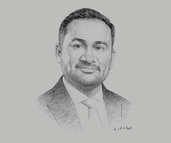Taher Shams: Interview

Interview: Taher Shams
What opportunities does Sharjah offer for private sector health care providers?
TAHER SHAMS: Demand for secondary and specialised care in Sharjah and the Northern Emirates has meant that most recent entrants into the local health care market have been existing operators from Abu Dhabi and Dubai which now see potential for expansion. Private sector providers have seen stronger demand as customers are increasingly looking for quality, accessibility and competitive prices. Furthermore, patients now expect faster delivery of services, and we have seen an increase in insurance coverage with out-of-pocket patients now accounting for less than 20% of the total.
The standardisation of the insurance landscape has also helped private sector operators, although Sharjah has not yet implemented mandatory coverage in the manner undertaken by Abu Dhabi and Dubai. As a result of the high level of digitisation in the UAE, almost all insurance claims are now submitted electronically, which has streamlined the claims system and reduced processing times to an average of 60-90 days.
Looking beyond private-sector health care operators primarily as service providers, there is also high growth potential in areas such as medical manufacturing. Given demand for medical products across the GCC, there are many pull factors for the localisation of production. As the domestic market for pharmaceuticals is expected to reach approximately Dh14bn ($3.8bn) by 2020, there is an opportunity for local producers of generics to target both the domestic and regional markets. Furthermore, the emirate should be able to increasingly position itself as a centre for research and development through collaboration with local universities.
How can the emirate attract health tourism?
SHAMS: We are in a strong position to benefit from health tourism due to our infrastructure, including air connectivity, which provides links to key inbound markets, particularly China. The global market for health tourism is increasingly competitive, and Sharjah must compete with other destinations within the GCC and South-east Asia. For example, Dubai is hoping to attract 500,000 medical tourists annually by 2020.
Local providers will need to improve their product and service offering through further innovation in order to remain competitive and attractive for patients looking for specialised treatment. Affordability is the main consideration for most medical tourists, so providers must offer cost-effective services to retain a competitive advantage and market share.
What challenges need to be addressed to promote growth in the health care sector?
SHAMS: Growth in the sector will depend primarily on the regulatory environment. The local and federal governments must implement policies and incentives that offer an attractive environment for medical industries and health care providers. This includes ensuring that fees and processes are as affordable and streamlined as possible so that any additional costs are not passed on to patients. Many GCC countries have similar strategies under way to develop their health tourism sectors, so we are all competing for a slice of the pie. Any additional costs will further challenge Sharjah’s ability to retain a competitive advantage in the market.
Mandatory international accreditation for private sector providers in the UAE by 2021 will help ensure quality and standards across the sector, but the key issue is to retain affordability. Public-private partnerships could help address this challenge as hospitals and service centres are capital intensive. Working directly with the government would increase information about the market and also guarantee support for providers.
Although local providers have not seen any shortage of labour due to low staff turnover, demand for qualified and experienced general medical staff and specialists may also pose a challenge as there is currently considerable competition for a very small pool of talent.
You have reached the limit of premium articles you can view for free.
Choose from the options below to purchase print or digital editions of our Reports. You can also purchase a website subscription giving you unlimited access to all of our Reports online for 12 months.
If you have already purchased this Report or have a website subscription, please login to continue.

